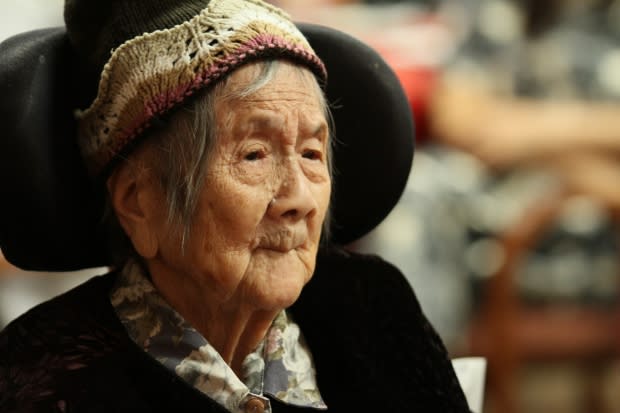This woman lived on her own until 107; expert says care in community key to aging population
More than a dozen residents at a Chinese nursing home in Toronto are part of the fastest growing age group in Canada — people 100 years old and older.
Foon Hay Lum is the oldest of the 14 centenarians at Mon Sheong Home for the Aged east of Chinatown.
Next month she'll celebrate her 111th birthday — a feat that might only be topped by the fact that until four years ago Lum lived on her own in a three-storey Parkdale home.
"She would just go up and down, do her own thing," said Helen Lee, Lum's granddaughter. "My father would come and do the grocery shopping, but she wasn't supervised at all."
Not all seniors are as lucky as Lum, but statistics show they are living healthier longer.
Last summer there were just shy of 10,000 centenarians across the country, made up of nearly 8,200 women and about 1,700 men, according to Statistics Canada. The national statistical office says that number could balloon to nearly 40,000 by 2051 when the first wave of baby boomers will be 100 or older.
To adapt to the country's growing aging population, Dr. Michael Rachlis believes Canada needs to change its approach to health care. The public health physician — who has been a consultant for the federal government and all 10 provincial governments on health policy — says the system is largely based on a model where someone gets sick or hurt and then goes to the hospital.

"We need a system that is much more based on public health and preventing people from getting sick," Rachlis told CBC News. "If you treat every illness with an older person in a hospital you're never going to afford to keep people healthy in the community."
One way to help keep elderly people out of hospitals, according to Rachlis, is to start providing the same subsidy funding and support that seniors in nursing homes get to those who meet the criteria for long-term care but live in the community — whether that be at home with some personal support, or through day programs.
"We currently have about 14 per cent of our hospital beds occupied by people who shouldn't be there, about half of those are seniors who are waiting for nursing homes, said Rachlis. "If our only solution to the aging of the population and frailty is nursing homes we're never going to be able to manage them and they're going to continually end up in hospital."
Fewest hospital beds of wealthy nations
That outcome is especially problematic in Canada, because it has the fewest number of hospital beds per 1,000 people compared to other wealthy jurisdictions, according to data from the Organization for Economic Co-operation and Development.
Canada has two hospital beds per 1,000 people, compared to peer countries like Australia, France, Germany, the Netherlands, New Zealand, Sweden and the U.S., which average 3.3 beds per 1,000 people.

On a provincial level, Ontario has the fewest hospital beds at 1.3 per 1,000, while Newfoundland and Manitoba have the most with 2.6 per 1,000. No data was provided by Quebec.
For examples of ways Canada can innovate, Rachlis points to countries like Denmark and Japan, which he says are decades ahead in terms of adapting to an aging population.
Denmark stopped building nursing homes in 1987, and has implemented a health-care system that starts by connecting younger seniors with services in the community to stay healthy and follows them as they get older by subsidizing support at home or supportive housing units.
Dementia-friendly communities in Japan
In Japan, Rachlis said whole cities are becoming dementia-friendly, so seniors can live safely in the community longer.
"So when an older person is wandering in the street, somebody can take them into a coffee shop or a sushi shop and the staff there have been trained with how to deal with people who wander around," Rachlis said.
Earlier this week, the Canadian government released a $50-million dementia strategy, which focuses on prevention, advancing therapies and helping patients and caregivers.
Rachlis considers the funding over five years "pathetic considering the needs," and believes the money would be best served getting communities working on how to adapt their urban design, health and social services to accommodate seniors and keep them in the community longer.

For most people that likely won't mean living independently for more than a century like Lum, but her lifestyle up until that point is a good example of how Rachlis's approach might work.
She'd never been on medication or gone to the hospital until an infection sent her there at the age of 107.
So what's Lum's secret to living a long, healthy life?
Her granddaughter thinks it has a lot to do with Lum drinking "so much water," eating steamed food and staying active as a lifelong gardener.
"So if we can have more gardening incorporated into our activities and stuff like that, I think that would be very good," said Lee.

